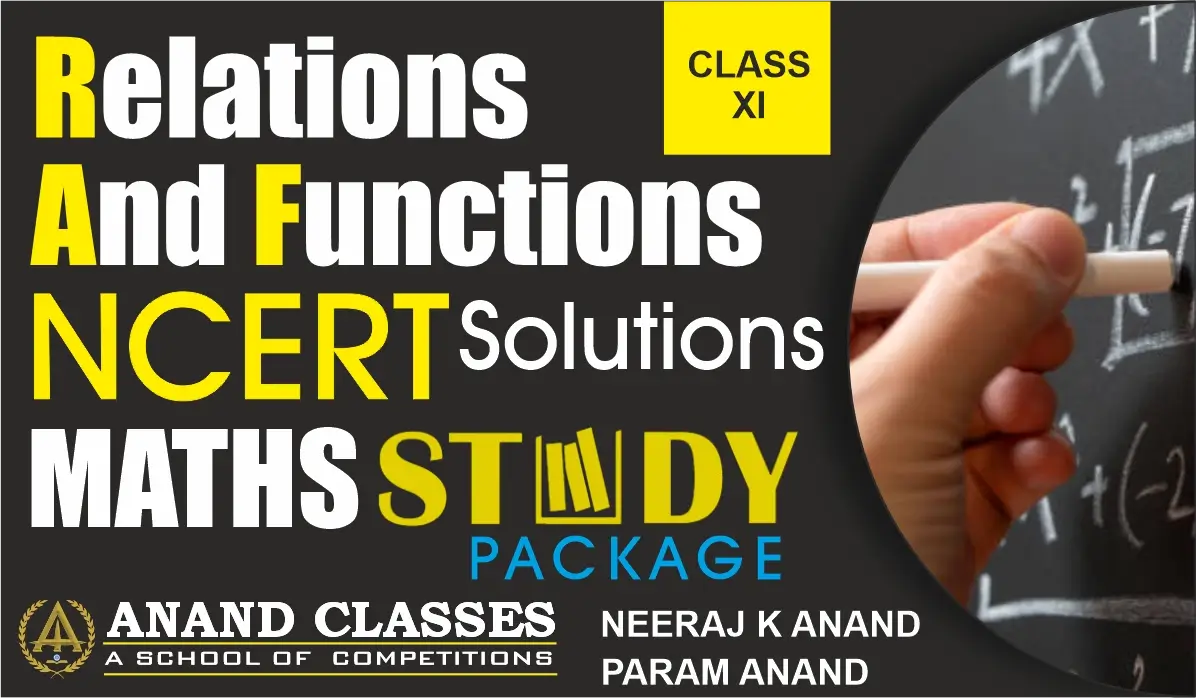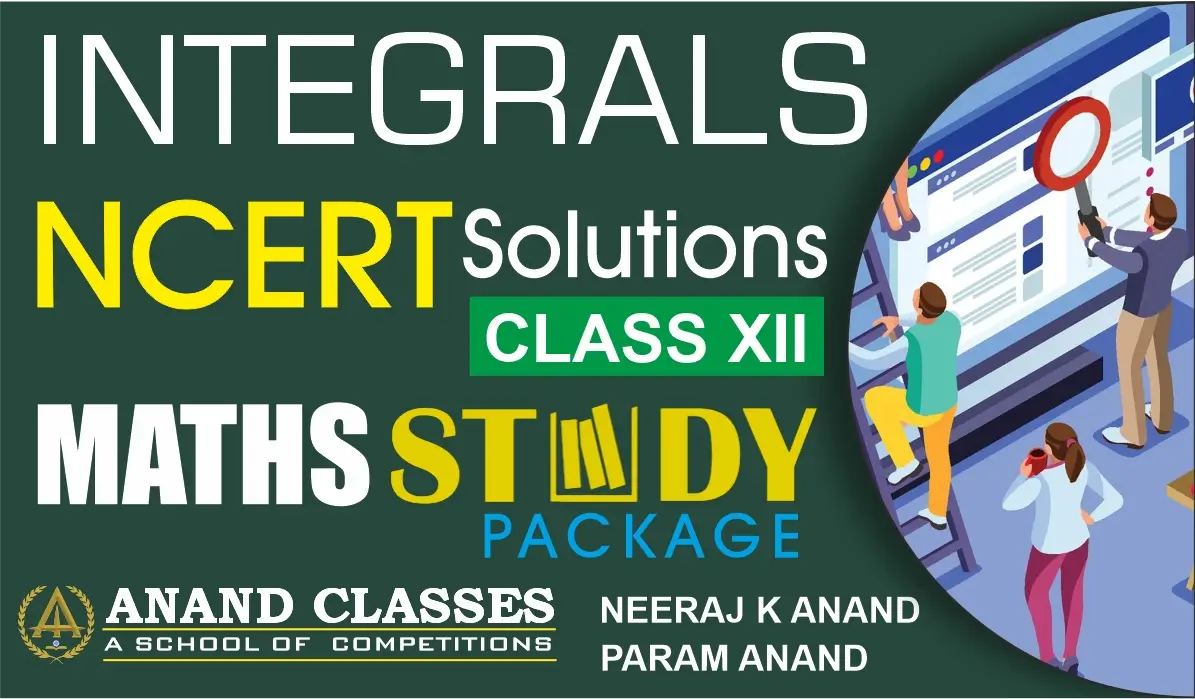Anand Classes provides complete NCERT Solutions for Class 11 Maths Chapter 2 – Relations and Functions Exercise 2.1 (Set-2) to help students strengthen their conceptual understanding of ordered pairs, Cartesian products, relations, and functions. These step-by-step NCERT solutions are prepared by expert teachers following the latest CBSE guidelines, ensuring clarity and accuracy for board exam preparation. Students can easily access detailed explanations, examples, and solved questions to enhance their problem-solving skills in Class 11 Mathematics Chapter 2. Click the print button to download study material and notes.
NCERT Question 6 : If $A \times B = \{(a, x), (a, y), (b, x), (b, y)\}$, find $A$ and $B$.
Solution :
Given,
$$A \times B = \{(a, x), (a, y), (b, x), (b, y)\}.$$
Since the Cartesian product of two non-empty sets $P \times Q$ is defined as:
$$P \times Q = \{(p, q) : p \in P, q \in Q\},$$
the first elements of the ordered pairs form set $A$ and the second elements form set $B$.
Therefore,
$$A = \{a, b\} \quad \text{and} \quad B = \{x, y\}.$$
Download Class 11 Maths Relations and Functions study material by Anand Classes — perfect for CBSE and competitive exam preparation.
NCERT Question 7 : Let $A = \{1, 2\}$, $B = \{1, 2, 3, 4\}$, $C = \{5, 6\}$ and $D = \{5, 6, 7, 8\}$. Verify that:
(i) $A \times (B \cap C) = (A \times B) \cap (A \times C)$
(ii) $A \times C \subseteq B \times D$
Solution :
Given,
$$A = \{1, 2\}, B = \{1, 2, 3, 4\}, C = \{5, 6\}, D = \{5, 6, 7, 8\}$$
(i) Verification of
$$A \times (B \cap C) = (A \times B) \cap (A \times C)$$
Compute the intersection:
$$B \cap C = \{1, 2, 3, 4\} \cap \{5, 6\} = \emptyset$$
So,
$$\text{L.H.S.} = A \times (B \cap C) = A \times \emptyset = \emptyset$$
Now,
$$A \times B = \{(1,1), (1,2), (1,3), (1,4), (2,1), (2,2), (2,3), (2,4)\}$$
$$A \times C = \{(1,5), (1,6), (2,5), (2,6)\}$$
Thus,
$$(A \times B) \cap (A \times C) = \emptyset$$
Hence,
$$\text{L.H.S.} = \text{R.H.S.} \quad \text{Verified.}$$
(ii) Verification of
$$A \times C \subseteq B \times D$$
We have,
$A \times C = \{(1,5), (1,6), (2,5), (2,6)\}$
$B \times D = \{(1,5), (1,6), (1,7), (1,8), (2,5), (2,6), (2,7), (2,8), (3,5), \\[1em](3,6), (3,7), (3,8), (4,5), (4,6), (4,7), (4,8)\}$
Since every element of $A \times C$ is present in $B \times D$,
$$A \times C \subseteq B \times D$$
Hence, verified.
Download Class 11 Relations and Functions NCERT solutions and notes by Anand Classes — ideal for CBSE exams and JEE foundational concepts.
NCERT Question 8. Let A = {1, 2} and B = {3, 4}. Write A × B. How many subsets will A × B have? List them.
Solution:
Given, A= {1, 2} and B = {3, 4}
So, A × B = {(1, 3), (1, 4), (2, 3), (2, 4)}
Number of elements in A × B = n(A × B) = 4
We know that,
For a set S with n(S) = m, number of subsets of S is given by n[P(S)] = 2m.
Thus, the set A × B has 24 = 16 subsets.
These subsets are: ∅, {(1, 3)}, {(1, 4)}, {(2, 3)}, {(2, 4)}, { (1, 3), (1, 4) }, { (1, 3), (2, 3) }, { (1, 3), (2, 4) }, {(1, 4), (2, 3)}, { (1, 4), (2, 4) }, { (2, 3), (2, 4) }, {(1, 3), (1, 4), (2, 3) }, { (1, 3), (1, 4), (2, 4) }, { (1, 3), (2, 3), (2, 4) }, { (1, 4), (2, 3), (2, 4) }, { (1, 3), (1, 4), (2, 3), (2, 4)}
NCERT Question 9 : Let $A$ and $B$ be two sets such that $n(A) = 3$ and $n(B) = 2$. If $(x, 1)$, $(y, 2)$, $(z, 1)$ are in $A \times B$, find $A$ and $B$, where $x, y$ and $z$ are distinct elements.
Solution :
Given:
$$n(A) = 3, \quad n(B) = 2$$
and
$$(x, 1), (y, 2), (z, 1) \in A \times B$$
We know that the first elements of ordered pairs form set $A$, and the second elements form set $B$.
So the first elements are:
$$A = \{x, y, z\}$$
And the second elements are:
$$B = \{1, 2\}$$
Thus,
$$A = \{x, y, z\}, \quad B = \{1, 2\}$$
Get complete Class 11 Maths Relations and Functions NCERT Solutions by Anand Classes — perfect for CBSE exam preparation and concept clarity.
NCERT Question 10 : The Cartesian product $A \times A$ has 9 elements among which are found $(-1, 0)$ and $(0, 1)$. Find the set $A$ and the remaining elements of $A \times A$.
Solution :
We know that if there are $p$ elements in $A$, then
$$n(A \times A) = p \times p = p^2$$
Given,
$$n(A \times A) = 9$$
So,
$$n(A) \times n(A) = 9$$
$$\Rightarrow n(A) = 3$$
Also, the elements $(-1, 0)$ and $(0, 1)$ are present in $A \times A$.
Since these ordered pairs are formed from elements of $A$, we get
$$-1, 0, 1 \in A$$
As $n(A) = 3$, therefore
$$A = \{-1, 0, 1\}$$
Now, list all ordered pairs in $A \times A$:
$$A \times A = \{(a, b) : a \in A, b \in A\}$$
Thus,
$A \times A = \{(-1,-1), (-1,0), (-1,1), (0,-1), (0,0), (0,1), \\[1em](1,-1), (1,0), (1,1)\}$
The pairs $(-1,0)$ and $(0,1)$ were already given.
Hence, the remaining ordered pairs are:
$$(-1,-1), (-1,1), (0,-1), (0,0), (1,-1), (1,0), (1,1)$$
Strengthen your Class 11 Relations and Functions concepts with expert NCERT solutions by Anand Classes — ideal for scoring full marks in CBSE exams.
Summary
Chapter 2 of the Class 11 NCERT Mathematics textbook, “Relations and Functions,” introduces the concepts of relations and functions. Exercise 2.1 focuses on basic problems related to defining, identifying, and representing relations and functions, including determining their domains and ranges. This exercise helps students understand how to work with functions, including the distinction between general relations and functions where each input is uniquely paired with an output.


